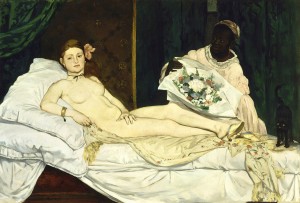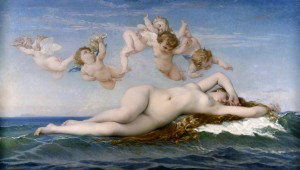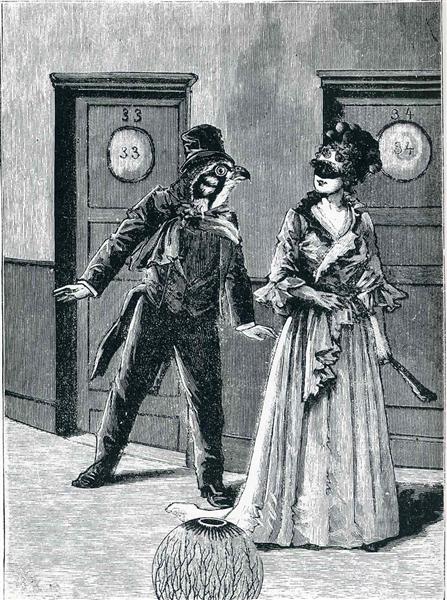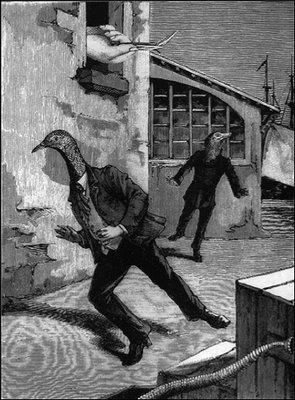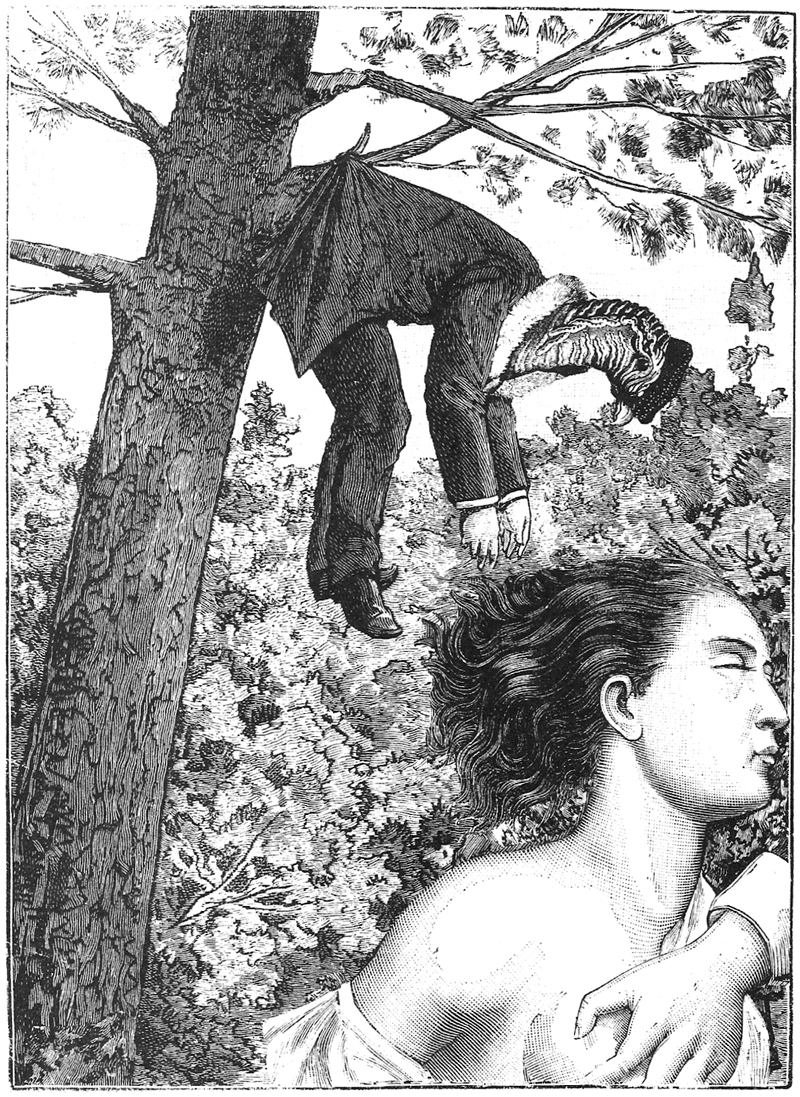Une semaine de bonte is filled with several intriguing images. I noticed that Max Ernst repeatedly uses the same animal-human comparisons, however, he constructs the images in a large variety of ways. The collage-book is filled with extremely detailed images containing these animal-human figures, but each image and section is unique and drastically different from the others. Since the collage-book is made up of images that are very different from each other, and because many of the images combined the figures of two different species, I began to think about the creative process of making the collage. The images are clearly put together to form a narrative, but I can’t help but feel like due to the nature of the work (combining body types and landscapes), there must be a great deal of improvisation that goes into the process (at least when tasked with creating hundreds of these collages).
Chimera
In Une Semaine de Bonté, Max Ernst presents us with many human-beast composites. The broad term for these creatures (according to Wikipedia) is Chimera, and although our Western understanding of these manifestations mainly comes from Greco-Roman tradition/mythology, depictions of beings composed of disparate body parts is a universal trope.
He focuses on birds, especially in Jeudi (Thursday): Le noir (blackness) and Mercredi (Wednesday): Le sang (blood).
My question: what are the cultural and literary implications of turning into a bird? What do birds traditionally symbolize, and how does Ernst manipulate artistic/cultural paradigms to add meaning to his novel?
A popular motif in Greco-Roman and, later, Victorian art is the Harpy. The harpies were typically birds with women’s heads. They are wind spirits–sometimes hideous hags, sometimes beautiful young women–known to scoop people up and carry them off as punishment. William Blake depicts these creatures in one of his last works:
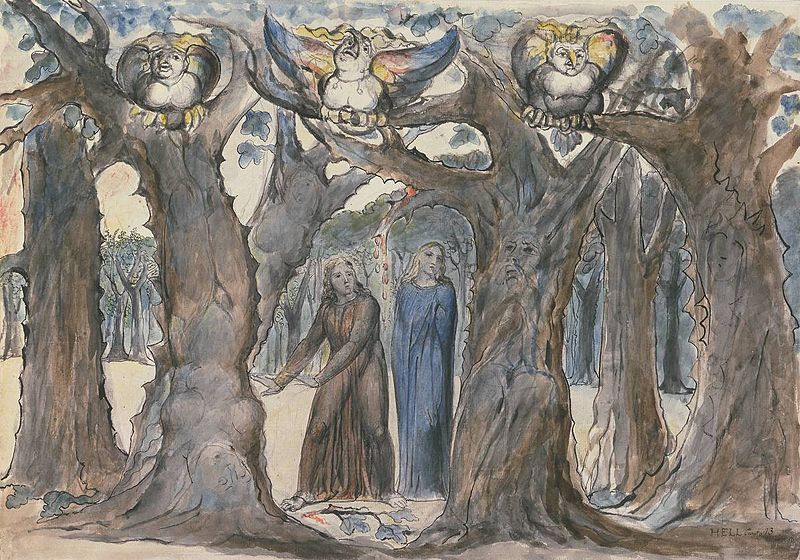
How do other monsters and mystical figures, like the Gorgons or Harpies, contrast with one of the most popular chimeric avian-human transformations: the angel (in addition to winged Greco-Roman figures such as Mercury/Hermes, Cupid/Eros)? Ernst clearly juxtaposes the angelic association of wings and birds with the base and disturbing actions of his characters.
Ernst’s Collages
Perhaps the most interesting part about Ernst’s collage-novel is that the pages don’t seem to be collages at all. When I think of a collage, I think of the projects we did in middle school, in which we cut and glued magazine pictures to a piece of construction paper. Ernst’s collages are seamless; it looks as if he drew everything. Maybe this is due to the fact that this is a copy and not his original work, but I am still floored by the time and precision it must’ve taken to put together collages like that.
Ernst and Printmaking
From what I understand, Ernst’s collages were made from images he cut out of other books. If I’m correct in assuming that books were made using traditional printing methods during his lifetime and that their images had to be etched into metal plates/blocks to be printed… does this mean that Ernst could be considered a printmaker as well as a collage artist? Thoughts are appreciated as I try to figure this out 🙂
Compare and Contrast Surrealism vs Surrealism
Looking at both Amphigorey and Une Semaine De Bonté we can begin to categorize similarities and differences. Compare and contrast, if you will. First, they are both in the surrealist genre- this is obvious. Une Semaine de Bonté utilizes our associations with animals, water, traditional depictions of the feminine and other popular tropes to critique society in a manner that brings the viewer beyond, or under, reality. Surreal. The same goes for Amphigory, named for the word amphirgory- or a “nonsense verse or composition.” Indeed, many of the stories within Amphigorey reflect this- they are funny, dark, deal with sexual perversions, and make no sense. All of this falls under the definition of surrealism and surrealist themes that are present in Une Semaine de Bonté. Amphigory, though, is perhaps less critically scathing to society.
Unlike in Une Semaine de Bonté, Amphigorey tends to deal more with the mundane, linking it directly back to Freud’s sense of the uncanny. Uncanny is the idea that something that is very familiar suddenly becomes eerie with unfamiliarity. It describes that second where you don’t recognize yourself in the mirror and you think somebody is standing behind you. While elements of this appear in Une Semaine de Bonté, they are not nearly as prevalent.
The Color of Water
It’s probably not particularly groundbreaking to be fascinated by the epigraphs, as they’re the only written part of the entire book. Still, there’s an element of collage there as well–Max Ernst is still cutting out parts of other source materials and repurposing them for his own use. There’s the same sense of cutting and pasting and rearranging.
In particular I liked the epigraph for the second book, Monday, the Element of Water, which is from Benjamin Peret’s endormi:
“D. — What do you see?
R. — Water.
D. — What color is this water?
R. — The color of water.
The enigmatic answer is both explored and emulated throughout the following section of the collage novel as the water takes on different characteristics–calm, cleansing, turbulent, relentless, unstoppable. The novel, of course, is in black and white, and the water is colored only by perception. The epigraph draws the reader deeper into the images and sets the tone for the section.
Surrealism and the unconscious
Surrealism was an art movement in the 20th century that explored the creativity of the unconscious mind. The concept of the unconscious was first developed by Sigmund Freud. Sigmund Frued is very well known psychologist for the creation of psychoanalysis. Although I may not believe that sex is the bases of all psychological problems,like Frued, I find his concept of the ego interesting. Frued brings about the topic of the superego, ego, and the Id.
Eventhough many may find psychoanalysis as the potential cause of surrealism because of the idea of the unconscious, I believe surrealism matches better with Analyctic Psychology. Created by one of Frued’s pupils, I think this concept better fits surrealism. It still deals with the unconscious but has a broader perspective on it which includes the spiritual. Analytic psychology’s creator, Carl Jung, mentions the idea of archetypes. Archetype are images/symbols that move from the collective unconscious to the personal unconscious. According to Jung the collective unconscious is repressed information the whole population shares as a collective group groups. one example of an archetype can be the serpent. It has appreared in various cultures around the world with holding different meaning. A well known image is the ouroboros. While psychoanalysis may be base of the idea of the unconscious, I feel like Analyctic psychology gives artist a broader idea of choices when it comes to surrealism. What do you think?
Animalistic Qualities in Un Semaine de Bonte
I believe Ernst was influenced by Darwinism in his portrayal of women. There is a very significant quality about Victorian dressing style that Ernst uses to imply that women are acting in an animalistic manner by deceiving men into thinking they are benign, sweet creatures. The exaggerated size of the dresses, on pages 102 & 103 for instance, enlarge women’s size and make them more immense than men. I find the elevated back of the women’s dresses kind of ridiculous: the dress looks like a camel’s back! I think Ernst suggests a connection between the appearance of animals and the behavior of women, women borrow the large appearance of animals to feel more significant and influence men with their seemingly charming looks. I came to this interpretation after looking at the way Ernst replaced body parts of men and women with these of animals, Ernst’s portrayal seemed too flexible and blunt to just mean a reference to animal-like behavior in humans, particularly women. In Page 98, the shape of the reptile is very similar to the shape of the women’s dresses, one almost thinks that the curled part of the woman’s dress on the right is the reptile’s tail, which looks like a fish’s tail, one that a reptile would not have. However, according to Darwinism, reptiles evolved from fish.
The presence of common ancestors between humans and animals allowed artists great flexibility in the way they characterized human behavior; the connection between animals and humans seemed more direct after Darwinism, in my opinion.
Surreal Space
One thing that is lost, seemingly intentionally, by the reproduced images of Une semaine de bonté is the ability to see the layers of images arranged on the page. The image we see instead is seamless; it is possible that Ernst meticulously cut along the linework of the old illustrations so as not to interrupt the flow of their contours. Upon reproduction, all traces of the layering disappear, but professor Serrano mentioned that in the originals, one can still see the layers. Collage intrigues because of the interaction of the partial artworks with the surface plane of the image. Frequently the layers combine to create a strange spatial dimension that is at odds with our typical perspectival approach to flat artwork like painting or prints. In this way, collage has a structural aspect; it emerges from tactile building and layering and is very much a spatially-dependent construct.
In many of the images in Une semaine de bonté it is unclear how the characters are oriented in relation to one another. Even elements of single characters seem to be at odds with other elements, like the slightly askew lion head in the very first collage. Often, the characters have an unclear or ambiguous relationship with the plane of the painting: figures hover, emerge from solid objects, are fragmented or obscured. The sculptural aspect that brings together many images in a multilayered construction also brings together the associated spatial planes from the borrowed art’s original contexts. Ernst works with the degradation of space, particularly architecture, in a lot of his collages. For example, water invading a woman’s bedroom or staircases leading to empty air. In my opinion, Ernst’s use of anomalous architecture stems from and develops the fundamental idea of collage. Collage works on more than just a content level. More than just the images are brought into conversation with one another, but also the spatial contexts of these images. When Ernst blends all of these decontextualized yet context-laden images together, he is literally creating ‘surreal space,’ generating a sense of nonreality moreso than any of the fantastical creatures he assembles.
The Male Gaze in Monday of Une semaine de bonté
I’m really interested in the Monday/water section of Ernst’s Une semaine de bonté (1934), especially in examining the male gaze and representation of women. I was struck by the image on page 51. It displays a room with a woman lying in a bed that seems to rest upon water. A man stands by the bed on top of the water with his hand on his chin, looking at the woman. His stance and gaze imply that he is assessing the woman. There are also human figures protruding from the water that appear desperate and frightened; one of the figures only has an arm emerging from the water, and no face is visible. I’m not sure what to make of the partially submerged figures, besides their relation to Ernst’s themes of violence, power and the grotesque, but I’m interested in the relationship between the male and female figures in this image. The female figure is rendered in the pose characteristic of the way female nudes have been most traditionally painted. She lies in a bed with ruffled sheets, propped up by pillows, with her hands behind her head in a passive and sensual pose. The woman in this image greatly resembles images of Venus in paintings like Cabanel’s The Birth of Venus. Artists have explored the male gaze in relation to the female nude for centuries. Manet’s Olympia is a prime example of a female nude that challenges tradition and confronts the viewer with discomfort because of the techniques Manet uses to create a sense of the subject’s (Olympia’s) awareness of the viewer. In this image Ernst doesn’t interact with the gaze in the same way as Manet does, but he refers to it very directly by depicting a man who represents the assessing gaze that the concept of the male gaze, which emerged in the 1920s, refers to. To me, this image seems to be a very direct commentary that criticizes the representation of women in art.
